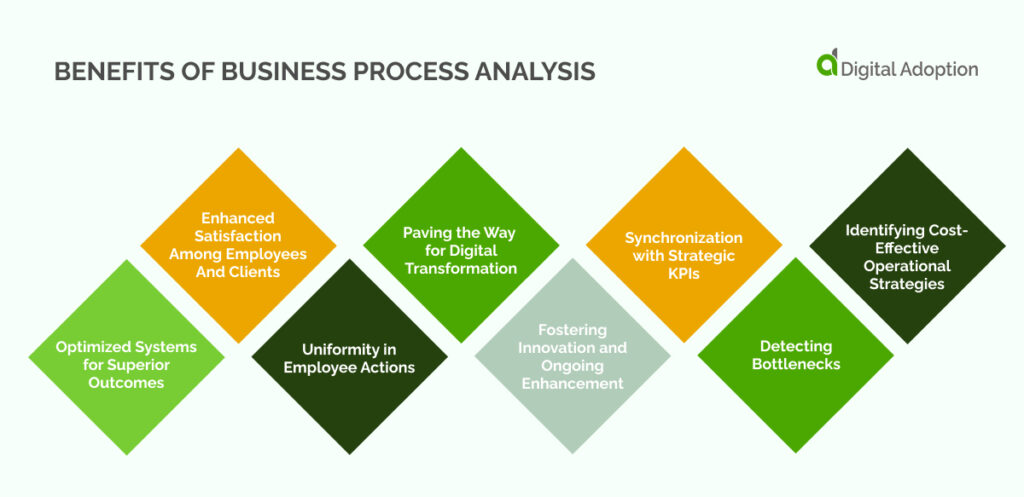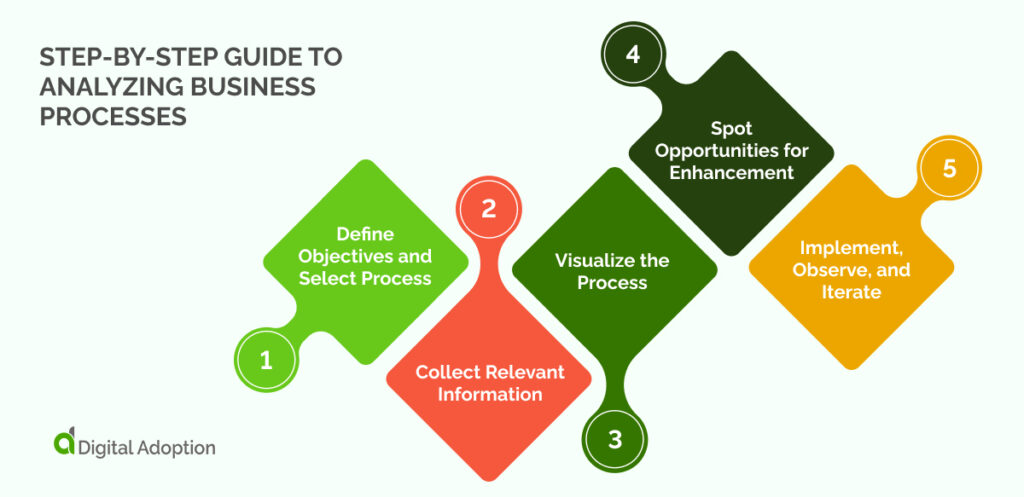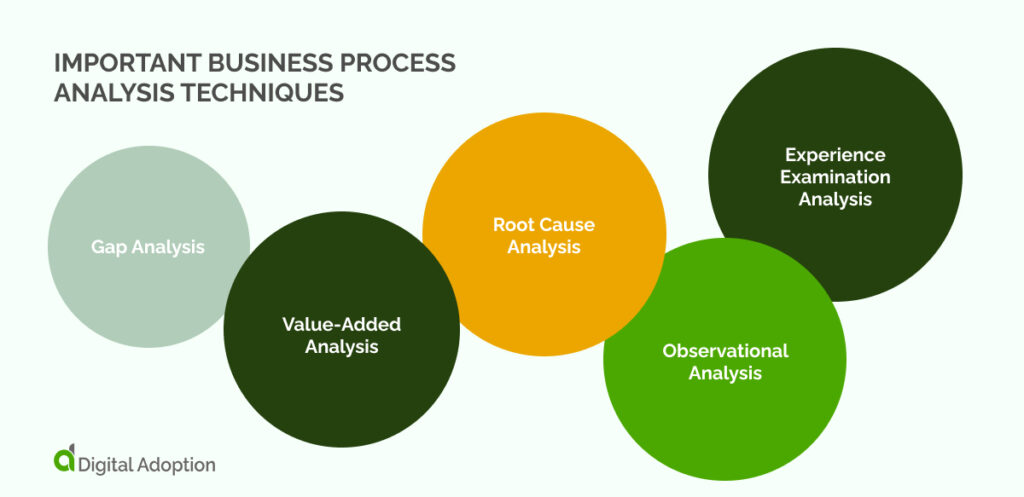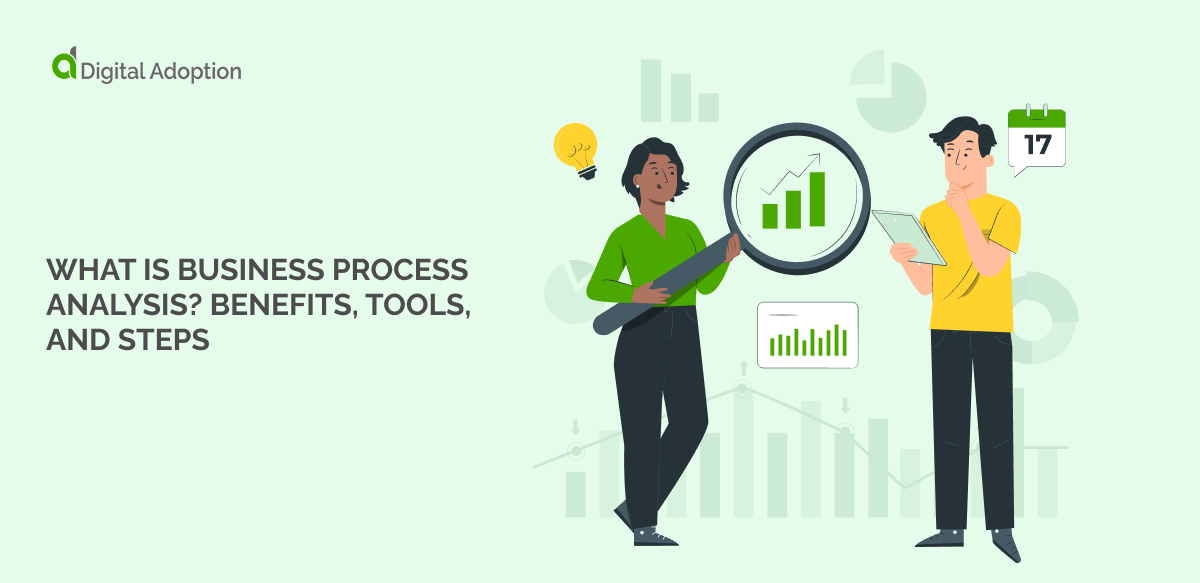Business process analysis (BPA) is a technique that enables organizations to scrutinize their internal workflows to uncover avenues for improvement.
It aids in pinpointing processes that can be streamlined or made more impactful, ensuring they are in sync with the organization’s objectives.
As an integral component of business process management (BPM) – a comprehensive structure aimed at overseeing organizational processes – BPA presents advanced organizations with a means to instill governance amidst complexity.
Regardless of size, every organization relies on systematic processes to achieve objectives. These could range from the straightforward task of engaging a potential client to the intricate process of issuing a purchase order.
Undoubtedly, your establishment has set processes for various tasks. But when did you last scrutinize them? How regularly do you assess if they amplify employee productivity or burden them with hindrances?
Lapses in business operations can result in economic setbacks and overshooting timelines. However, pinpointing snags in a workflow and discerning areas of enhancement can be challenging.
By the end of this guide, you will understand:
- What business process analysis is, and why is it important?
- The benefits of business process analysis
- The difference between business process analysis and business analysis
- How to analyze business processes using a step-by-step guide
- The most critical business process analysis examples or techniques
- The benefits of business process analysis tools
- Some examples of business process analysis tools
- What Is Business Process Analysis?
- Why Is Business Process Analysis Important?
- Benefits of Business Process Analysis
- The Difference Between Business Process Analysis Vs Business Analysis
- Step-By-Step Guide To Analyzing Business Processes
- Important Business Process Analysis Techniques
- Benefits of Business Process Analysis Tools
- Examples of Business Process Analysis Tools
- What’s Next For Business Process Analysis?
What Is Business Process Analysis?
Business process analysis is a tool organizations employ to enhance their efficiency. It entails scrutinizing a process and pinpointing areas for improvement.
Neglecting to analyze your processes can lead to the continuation of redundant or outdated methods, especially as an organization grows and evolves — with more hands on deck and the adoption of emerging technologies.
Regularly reviewing and assessing your processes helps pinpoint and rectify inefficiencies and aids in documenting every step, thereby refining training resources for new employees.
Why Is Business Process Analysis Important?
Organizations stand to gain significantly from conducting a business process analysis. Periodically reviewing and assessing processes is crucial for pinpointing areas of enhancement.
In the current technological climate, characterized by continual innovation from competitors, organizations have a significant risk of becoming obsolete should they adhere to antiquated methodologies.
As a best practice, a comprehensive business process analysis should be undertaken before integrating new technological solutions such as automation. Being well-prepared is a cornerstone of achieving success.
Consider the issue of bottlenecks – a challenge every organization encounters occasionally. How best to navigate these operational roadblocks?
Clear signs of bottlenecks in your operations signal an urgent need for business process analysis to propel your company’s growth and efficiency.
Manifestations of these bottlenecks can range from recurrent delays and heightened customer grievances to confusion among stakeholders and a dip in productivity.
Benefits of Business Process Analysis

Understanding BPA empowers businesses to refine their operations, offering manifold benefits for those who engage in it consistently.
Here are the advantages you stand to enjoy when you delve into analyzing your organizational workflows:
Optimized Systems for Superior Outcomes
A prevalent misconception among managers and business leaders is that only struggling enterprises need to tweak their operations.
Yet, even if a system functions well, it doesn’t mean there’s no room for improvement. If a system has sustained over time, its robustness is evident.
However, striving for the best is a mantra to abide by. Building on the strengths of prevailing processes not only augments systems but also boosts productivity.
This enhanced framework remains familiar, ensuring a smoother transition for teams, culminating in goal realization.
Enhanced Satisfaction Among Employees And Clients
A company’s revenue isn’t serendipitous. It’s the result of effectively catering to consumer needs. Ensuring that the procurement and product delivery processes are simple but streamlined and user-friendly is essential.
In parallel, efficient systems cultivated post-BPA foster a positive workspace where employees can efficiently serve clients and achieve organizational objectives.
Uniformity in Employee Actions
Top-tier companies prioritize standardized business processes. By leveraging BPA to formalize and document procedures, there’s a surge in operational consistency.
This structured approach eliminates ambiguity, enabling staff to confidently execute tasks.
Such clarity facilitates performance tracking and adherence monitoring, promoting a culture of accountability and tangible outcomes.
Paving the Way for Digital Transformation
BPA plays a pivotal role in highlighting areas needing overhaul before embarking on a digital transformation journey.
Assessing and refining processes pre-transformation ensures amplified performance coupled with cost optimization.
Fostering Innovation and Ongoing Enhancement
While repetition can become tedious, the goal isn’t to swap out effective processes but to augment them.
Innovative approaches can unveil superior operational strategies, especially when existing methodologies are outdated or subpar.
BPA acts as a catalyst for innovation and ongoing enhancement, maximizing ROI through business process transformation (BPT).
Synchronization with Strategic KPIs
As businesses expand, maintaining interdepartmental coherence becomes challenging. However, BPA facilitates real-time insights into bridging communication voids.
Moreover, it refines the integration process for newcomers, ensuring everyone is aligned with their roles, leading to improved results.
Detecting Bottlenecks
BPA assists in discerning operational inefficiencies.
For instance, in e-commerce, if delays lead to order cancellations, a meticulous analysis can pinpoint the exact cause, enhancing delivery timelines, reducing cancellations, and bolstering profit margins.
Identifying Cost-Effective Operational Strategies
Building on the earlier point, a notable benefit of business process analysis is its ability to streamline business transactions through efficient and concise methods.
By implementing these refinements, businesses can mitigate mistakes, elevate performance standards, and strengthen customer confidence in the company’s offerings.
The Difference Between Business Process Analysis Vs Business Analysis
Business Process Analysis (BPA) and Business Analysis are pivotal methodologies in organizational advancement, spotlighting unique facets of operational dynamics.
Here’s how they stack up against each other:
Business Process Analysis (BPA)
- Definition: BPA is a niche within business analysis, zoning in on scrutinizing and enhancing an organization’s operational processes. Its mission is to amplify process efficiency, streamline performance, and heighten effectiveness.
- Core Functions: BPA delves deep into the structure of tasks and functions, unearths process bottlenecks, and recommends upgrading workflow dynamics.
- Characteristic: Recognizably process-driven, BPA employs tools like flowcharts, process maps, and diagrams to visualize operations, with its eyes set on bolstering operational agility and minimizing redundancy.
Business Analysis
- Definition: This is a comprehensive study of an organization, targeting areas from process dynamics to strategies, system integrations, and organizational structures. Business analysts wear multiple hats—from identifying business needs and challenges to charting solution blueprints.
- Core Functions: Their responsibilities span understanding overarching business landscapes, outlining project or initiative prerequisites, and bridging communication channels among stakeholders.
- Characteristic: BAs are experts in data analyses, requirements management, and process optimization. They can navigate through complex business operations and provide valuable insights for stakeholders.
This might mean orchestrating feasibility assessments, crystallizing business needs, steering change management efforts, or ensuring that business objectives and tech solutions resonate.
Here is a breakdown of how business process analysis and business analysis differ:
Scope
BPA zeroes in on evaluating and refining specific organizational processes.
Business Analysis casts a broader net, delving into diverse business components, including strategy, need assessment, and tech integrations.
Focus
BPA is all about process agility, optimization, and bottleneck obliteration.
Business Analysis is anchored in decoding business necessities, troubleshooting, and ushering in transformative shifts.
Tools and Techniques
BPA leverages tools like process mapping, flow diagrams, simulations, and analytical methodologies to fine-tune processes.
Business Analysis deploys tools such as stakeholder dialogues, SWOT evaluations, requirement extractions, and cost-effectiveness studies.
Outcome
BPA’s endgame is a smoother, highly efficient process mechanism.
Business Analysis aims for a holistic grasp of business demands, potential solution pathways, and implementable strategies.
Stakeholders
BPA engages with stakeholders intrinsically involved in honing process efficacy and performance.
Business analysis interacts with stakeholders, from leadership echelons and IT brigades to end-users and external allies.
Role
BPA professionals are laser-focused on elevating process standards and outcomes.
Business analysts don a multi-dimensional role, converting business visions into tangible action plans, fostering stakeholder communication, and ensuring harmonization across diverse organizational arms.
Step-By-Step Guide To Analyzing Business Processes

Analyzing business processes is an essential part of any organization’s success. It helps identify inefficiencies, streamline operations, and ultimately improve the overall performance of the business.
This process can be complex and overwhelming, especially for those new to the concept of business process analysis.
To ensure a successful BPA initiative, follow our step-by-step guide below:
Define Objectives and Select Process
Determine your goals for implementing BPA. Choose a specific business process for examination and set clear metrics, benchmarks, and plans to gauge the success of your changes.
Collect Relevant Information
Once the target process is selected, amass all pertinent data, documents, and resources. Engage stakeholders who interact with the process regularly for insights. Their firsthand experiences will offer a comprehensive understanding of how the process operates within the company.
Visualize the Process
With the data at hand, illustrate the process from beginning to end. While traditional methods like paper sketches or whiteboards work, modern workflow management tools can offer a more detailed visualization of the entire process.
Spot Opportunities for Enhancement
Examine the visualized process and pinpoint areas that can benefit from enhancement. This might entail removing repetitive tasks, introducing automation, or tweaking parts of the workflow to boost efficiency.
Implement, Observe, and Iterate
Act on the identified improvements and observe the process’s performance against the initially set benchmarks and goals. BPA is an ongoing journey, so maintain regular monitoring. Be open to revisiting and refining the process as new improvement opportunities emerge, steering clear of a complacent approach.
Important Business Process Analysis Techniques

For successful business process analysis, you must arm yourself with tried-and-tested techniques and tangible metrics, discarding reliance on mere theory or guesswork.
While the idea may seem straightforward – identify the problematic process, delve deep into the issues, and innovate – it’s more intricate in practice.
A myriad of strategies can lead to rewarding outcomes. However, it’s essential to understand that not all yield identical results.
Misjudged analysis might exacerbate issues if underlying obstructions remain unidentified.
Examples of business process analysis strategies include:
Gap Analysis
Gap Analysis, sometimes termed “needs analysis,” is pivotal in evaluating diverse organizational performances. Its role?
To help businesses diagnose their present status, pinpoint discrepancies between current achievements and desired success levels, and assess if the company optimally utilizes its resources.
This technique recognizes the existing scenario by examining factors like finances, time, and manpower and contrasts it with an aspirational position. By identifying these disparities, leaders can blueprint an actionable plan to propel the company ahead.
The methodology of gap analysis unfolds over four stages:
- Setting Organizational Goals: Define clear, measurable, and achievable objectives.
- Assessing the Current Situation: Harness historical data to gauge present performance vis-à-vis objectives.
- Data Gap Analysis: Review collected data to comprehend why the performance isn’t hitting the mark.
- Report Compilation: Prepare a comprehensive report detailing gaps and an action plan to meet company targets.
Value-Added Analysis
This technique targets process inefficiencies and identifies the indispensable components of a product or business process. The objective is to accentuate steps that add genuine value and eliminate redundant ones, ensuring the end product’s value surpasses its creation cost.
To conduct a rigorous value-added analysis, each activity linked to a process must undergo thorough scrutiny. This methodology can be conceptualized as:
Value added = Post-activity product value – Pre-activity product value
Activities are then grouped under:
- Real-Value Added (RVA) Activities: Actions enhancing customer experience.
- Business-Value Added (BVA) Activities: Internal actions aiding organizational objectives that customers overlook.
- Non-Value Added (NVA) Activities: Steps lacking customer and business value.
Root Cause Analysis
RCA delves deep to pinpoint the actual catalysts behind process challenges. It seeks to address root problems rather than superficial symptoms.
Visual tools, like the Ishikawa diagram, can illuminate where process breakdowns occur and their triggers.
Observational Analysis
This technique provides a real-time perspective by directly observing processes and uncovering steps that might be overlooked or underestimated. It also serves to confirm the workers’ comprehension of the process.
The challenge is ensuring the observer’s presence doesn’t skew the procedure.
Experience Examination Analysis
This strategy capitalizes on the wisdom of seasoned employees. Unlike observational analysis, it gleans insights from those with years of on-ground experience.
This method can expose links between root causes and inefficient activities and is especially beneficial in capturing the nuances that only long-standing employees would recognize.
For businesses with veterans possessing rich process knowledge, leveraging this method ensures the retention of unique insights, proving invaluable for the entire organization.
Whether corroborating findings from other analytical methods or seeking a deeper understanding, experience analysis is indispensable.
Benefits of Business Process Analysis Tools
The rise of business process analysis (BPA) software has been driven by a need for streamlined operations, optimized productivity, and clear communication among teams.
Here are seven core advantages of employing BPA tools:
Boosting Employee and Customer Satisfaction
With BPA tools, complex steps are simplified, and processes become more efficient. This results in smoother operations for employees, allowing them to meet deadlines effectively.
From the customer’s perspective, BPA can help identify and rectify pain points in their journey, such as unnecessary delays due to redundant steps, leading to a more satisfactory experience.
Minimizing Errors
Traditional manual processes often become convoluted when multiple individuals handle them, each with their own unique approach. With their systematic and automated approach, business process analysis tools offer the advantage of reducing errors, leading to enhanced reliability, accuracy, and cost savings for the business. This precision also enables the development of high-quality and cost-effective product features.
Seamless Integration
Compatibility is seldom an issue with leading BPA tools.
Whether you’re using a Chrome browser or a mobile device running Android or iOS, these tools are designed to integrate smoothly, allowing users to manage processes effortlessly, regardless of their device.
Saving Precious Resources – Time and Money
Efficiency is the main focus of business process analysis. Automating repetitive tasks frees up time for more strategic activities, directly impacting the company’s bottom line.
Many BPA platforms also offer comprehensive solutions, eliminating the need for multiple subscriptions and leading to financial savings.
Optimizing Communication Among Team Members
Effective communication is critical in ensuring that teams work synergistically. BPA tools provide a platform for streamlined communication. Visualizing processes allows team members to identify bottlenecks and work together to brainstorm solutions.
Sharing, saving notes, and model creation become more straightforward, fostering a more cohesive team environment.
Centralizing Workflows
An effective BPA tool guarantees that processes are clear, concise, and centralized. Such a system eliminates redundant efforts, reduces the chances of errors, and ensures that teams operate cohesively.
Enhancing Visual Representation and Collaboration
The adage “a picture is worth a thousand words” rings true in the context of BPA tools. These tools facilitate the development of process diagrams, which provide a visual representation of workflows. This simplifies understanding and makes it more straightforward to pinpoint areas that require improvement.
Such visual representations, combined with collaboration features, enable stakeholders to share insights, provide feedback, and work together toward optimizing processes.
Examples of Business Process Analysis Tools
Many business process analysis tools are available in the market, each boasting advanced features to enhance your analysis and foster better teamwork.
BPA tools are a boon for organizations inundated with intricate processes that span multiple departments, resources, or data repositories.
They offer the convenience of creating diagrams, visualizing workflows, sharing insights with stakeholders, archiving notes, designing models, and activating automation functions.
Here’s a list of some renowned business process management tools:
- Adonis
- Asana
- BIC Process Design
- Bpanda
- FlowRight
- Bizagi
- Camunda
- Wrike
- Zoho One
What’s Next For Business Process Analysis?
Business process analysis is a technique employed to examine and enhance the efficiency of a process.
When done well, business process analysis can strengthen operational outcomes and boost customer contentment.
Each time you issue a purchase order, greenlight a travel request or address a customer query, you likely follow a consistent sequence of actions.
Undertaking a business process evaluation allows you to refine these sequences, ensuring that every step adds value and there’s no redundancy.
It’s essential to distinguish between business process analysis (BPA) and business analysis (BA). While they might sound alike, their focus is distinct. BPA zeroes in on scrutinizing business workflows, utilizing data from this examination to propose improvements.
Conversely, business process transformation delves deeper into pinpointing specific organizational challenges or necessities, encompassing areas like finance, research, recruitment, or budgetary adjustments rather than strictly process-oriented matters.







![18 Examples of AI in Finance [2025]](https://www.digital-adoption.com/wp-content/uploads/2025/06/18-Examples-of-AI-in-Finance-2025-300x146.jpg)
![14 Examples of AI in Manufacturing [2025]](https://www.digital-adoption.com/wp-content/uploads/2025/06/14-Examples-of-AI-in-Manufacturing-2025-300x146.jpg)




